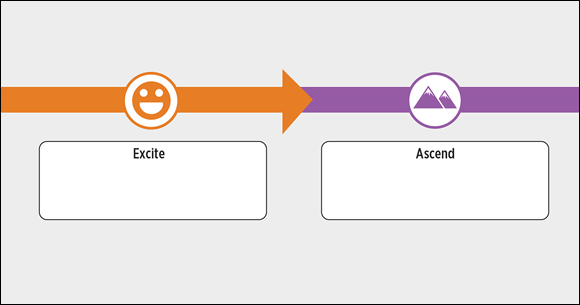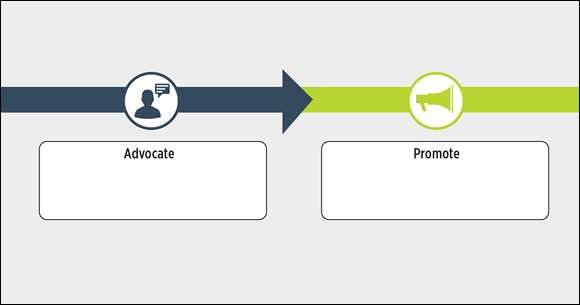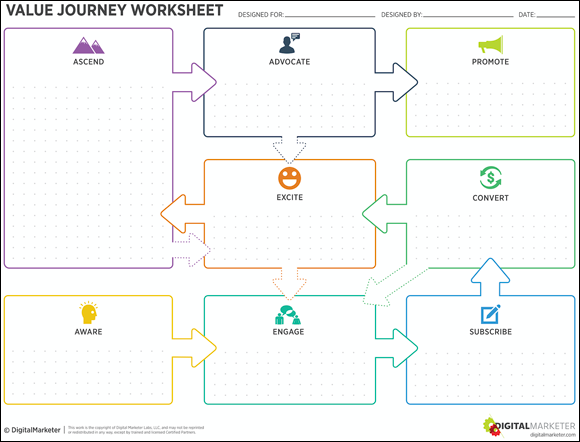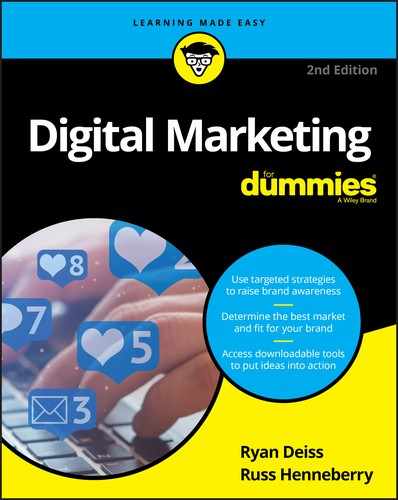Chapter 2
Choosing the Right Marketing Campaign
IN THIS CHAPTER
![]() Defining the goals of your digital marketing
Defining the goals of your digital marketing
![]() Utilizing the three main digital marketing campaigns
Utilizing the three main digital marketing campaigns
![]() Learning which digital marketing campaigns you should employ, and when
Learning which digital marketing campaigns you should employ, and when
Digital marketing is a broad term that can mean anything from posting an image of your product on Facebook to crafting an email subject line to optimizing a blog post for search engine traffic. Digital marketing involves many seemingly disconnected tactics, and that’s what makes this chapter so important.
This chapter helps you understand what a marketing campaign is. We explain the three different types of campaigns and how and when to use them so that you can use these strategies effectively in your digital marketing campaigns.
Every business is interested in generating leads, making sales, retaining the customers they have, and selling them more of the company’s products or services. Achieving each of these goals requires a different approach, however. In this chapter, we help you decide what you want your digital marketing to accomplish by identifying your business objectives, because those objectives are what should dictate the campaigns you construct and, ultimately, the tactics you employ.
Establishing Marketing Objectives
Before you start a blog, open a Pinterest account, or start gathering email addresses, you need to choose your business goals. When you know what you want to accomplish, you’ll be able to direct your energy into the right marketing campaigns and employ marketing tactics that move the needle on the right business metrics.
Here are six common goals that your digital marketing strategy can affect:
- Increasing problem and solution awareness: Your online marketing can help prospective customers become aware of something they need, an effect called problem awareness. Your marketing can also make prospective customers aware that your company provides a solution to a problem — called solution awareness. Your objective is to help people realize that you can take them from the “Before” state, in which they have a problem, to the desired “After” state, in which they have obtained a positive solution. (We cover this idea in greater detail in Chapter 1.)
- Acquiring new leads and customers: Gaining more leads and customers is a primary objective of most businesses. Without generating new leads and customers, your business will never grow beyond what it is now. You need to bring in new blood in order to scale your business.
- Activating leads and customers: If you’ve been in business for more than a few months, you likely have leads and customers who have yet to buy or haven’t bought in a while. You can use your digital marketing campaigns to encourage people to buy from you for the first time, as well as to remind past customers who haven’t purchased from you lately of the value you bring and why they should buy from you again. Your digital marketing campaigns can activate these dormant leads and customers and help keep your business in mind.
- Monetizing existing leads and customers: Acquiring new leads and customers is expensive and time consuming. Don’t forget to create digital campaigns intended to sell more products and services to those new leads and customers. Monetization campaigns make upsell, cross-sell, and other types of offers to sell more to your best leads and customers.
- Onboarding new leads and customers: New leads and customers deserve special treatment simply because they are new. They need to be taught who you are and how to be successful with what they’ve purchased. To achieve this goal, create content such as welcome emails or welcome packets that tell people how to use your product or service, what they can expect, and where they can go if they need help with their purchase.
- Building community and advocacy: To move prospects, leads, and customers beyond a shallow, transactional relationship, you need to build campaigns that create communities of advocates and brand promoters. One of the most effective ways to achieve this advocacy is through social media, such as through a Facebook group or a Twitter page. Here, people can reach out if they have praise for or questions about your product or service. By creating an outlet, you help to cultivate a sense of community for your customer base, which leads to increased satisfaction and loyalty. Find more on social media tactics in Chapter 9.
Defining a Digital Marketing Campaign
Meeting your business objectives and moving a customer through the customer journey (discussed in Chapter 1) from ice-cold prospect to raving fan requires actions. Those actions, if coordinated properly, are called campaigns. Digital marketing campaigns, as we define them in this book, have a set of specific characteristics. Digital marketing campaigns are:
- Objective based: Digital marketing campaigns are coordinated actions intended to achieve a specific business goal.
- Multiparted: Every digital marketing campaign requires assets like content and landing pages, as well as tools like email software or web forms. But those assets aren’t enough to ensure the success of your campaign; you need the ability to make those assets visible. In other words, you need traffic. Yet another part of every campaign is the measurements you track so that you can determine how it is performing.
- Seamless and subtle: It’s worth pointing out that these multistep, multipart campaigns are most successful if you walk the prospect gradually through the customer journey (for more about the customer journey, see Chapter 1). To help move people through the customer journey, you need to include a call to action (CTA) within your campaign. A CTA is an instruction to your audience designed to provoke an immediate response. Usually, a CTA includes an imperative verb to convey urgency, such as “buy now,” “click here,” “shop today,” “watch this video,” “give us a call,” or “visit a store near you.” Next, a well-oiled marketing campaign removes the friction between the prospect and the action you want that prospect to take. An extreme example is to ask an ice-cold prospect to buy a $10,000 product or service. Such a tactic would be neither seamless nor subtle. In the coming chapters, you find out how to structure your campaigns in a way that moves your cold prospects to become repeat buyers and purchasers of high-ticket items.
- In flux: The word campaign often refers to an initiative with a short life span, but as it is defined in this book, a campaign can be something your business runs for as little as a day or as long as several years. The advantage of digital campaigns over physical ones (such as direct-mail campaigns) is that small tweaks and even wholesale pivots are much simpler in a digital environment. As a result, you can optimize digital marketing campaigns on the fly to achieve the best results.
The most important takeaway from this section is that a campaign is a process, not a single event that is made up of numerous steps and parts. Digital marketing campaigns might seem complicated to you now, but rest assured that campaigns can be extremely simple, and we cover everything from asset creation to traffic and measurement in this book.
Understanding the Three Major Types of Campaigns
Although you may have many business goals that you want to affect through your digital marketing, you’ll find that you can meet most objectives with three broad categories of digital marketing campaign: Acquisition, Monetization, and Engagement.
Each of these types of digital marketing campaigns has a very specific role to play in your business, as follows:
- Acquisition campaigns acquire new prospects and customers.
- Monetization campaigns generate revenue from existing leads and customers.
- Engagement campaigns create communities of brand advocates and promoters.
The following sections explain these types of campaigns in much more detail.
Campaigns that generate new leads and customers
If your goal is to raise awareness for the problems you solve or the solutions you provide, or if you’re just looking to acquire new leads and customers, you need an Acquisition campaign.

FIGURE 2-1: Acquisition campaigns move prospects from the Aware to Converted stages.
The stages of the customer journey that Acquisition campaigns complete are the following:
- Make Aware: To bring in new leads and customers, you need to reach out to what amounts to complete strangers. You should structure Acquisition campaigns to reach prospects who are completely unaware of the problem you solve or the solutions you provide.
- Engage: The movement from Make Aware to Engage is often accomplished by providing value to the prospect, usually in the form of entertainment, inspiration, or educational content, before asking her to buy something or commit a significant amount of time. This is known as content marketing, a strategic marketing method focused on creating and distributing valuable, relevant, and consistent material designed to attract, retain, and ultimately drive a customer to a profitable action. Content marketing consists of a broad spectrum of activities and types of content, including blogging, videos, social media updates, images, and more. We cover content marketing in more detail in Chapter 4.
- Subscribe: At this stage, the prospect has given you permission to market to him. At the very least, he has connected with you on social channels (Facebook, LinkedIn, and others) or, ideally, has become an email subscriber. The Subscribe state is a critical stage to reach in the relationship because you can now continue the conversation with more content and offers.
- Convert: The transformation of a prospect from being merely interested and subscribed to converted is the final stage of an Acquisition campaign. At this point, the prospect has placed trust in your organization by giving you either money or a significant amount of her time. Don’t forget that your marketing should be gradual and seamless, particularly online, where you must often build trust with someone you’ve never actually met. If this final stage of your Acquisition campaign involves a sale, it shouldn’t be a risky (think expensive or complex) purchase. The goal here is to simply transform the relationship from prospect to customer.
Note that Acquisition campaigns are not about profit. Although you might be making sales at the Convert stage, the goal of those sales is not return on investment (ROI) but on acquiring leads and buyers. This idea can seem counterintuitive, but keep in mind that customer and lead acquisition is different from monetization. These two campaign types have different goals, tactics, and metrics.
Campaigns that monetize existing leads and customers
If your business objective is to sell more to the customers you already have or to sell high-dollar, more complex products and services and profit maximizers (as described in Chapter 3), you need a Monetization campaign. In short, the goal of a Monetization campaign is to make profitable sales offers to the leads and customers you acquired with your Acquisition campaigns.
The stages of the customer journey completed by Monetization campaigns and shown in Figure 2-2 are the following:
- Excite: You target Monetization campaigns at customers who have already spent time learning something from you, or have already purchased something from your business. Savvy digital marketers build campaigns that encourage prospects or customers to get value from the interactions they’ve already had with your business.
- Cause customers to ascend: For every group of people who purchase something, some percentage of them would have bought more, or more often, if given the chance. For example, for every buyer of a Rolex watch, some percentage would buy a second (or third or fourth!) watch, or would buy the most expensive Rolex watch if presented with the opportunity. This concept is critical not only to digital marketing but also to your business goals. Your Monetization campaigns should capitalize on this concept by making offers that increase the value of your existing leads and customers.

FIGURE 2-2: Monetization campaigns create excitement and cause existing leads and customers to ascend to a higher level of purchasing.
Campaigns that build engagement
If your business objective is to successfully get new customers on board and move new leads and customers from being prospects to fans of your brand, or to build a community around your company, brand, or offers, you need an Engagement campaign. The most beloved companies create online opportunities for customers and prospects to interact with each other and with the brand. Companies that build engagement into their marketing enjoy the benefits of customer interactions that go beyond the simple transaction of buying goods and services.
The stages of the customer journey completed by Engagement campaigns and shown in Figure 2-3 are the following:
- Advocate: You can create marketing campaigns to give your best customers the ability to recommend your business through testimonials and customer stories. These advocates defend your brand on social media and recommend your products and services to their friends and family when prompted. Advocates may talk about and defend your brand, but they’re passive about it. They won’t go out of their way to do it. That’s the main difference between an Advocate and a Promoter (discussed next).
- Promote: Customers who actively seek to promote your business are worth their weight in gold. These are the customers who create blogs and YouTube videos about your products and services. They tell the story of your brand and their success with it on social channels, and do everything they can to spread the good word about the value you provide. They are true fans and believers in your product and what your business stands for. These people are your brand advocates.

FIGURE 2-3: Engagement campaigns can lead to the creation of brand advocates and brand promoters.
When done right, Acquisition, Monetization, and Engagement campaigns seamlessly move people through the customer journey. These three strategies help people go from their “Before” state in which they have a problem to their desired “After” state of having gained a positive outcome through your product or service. (We discuss the customer journey in greater detail in Chapter 1.) Figure 2-4 shows all the stages a person goes through, ideally, in the customer journey. Use the Acquisition, Monetization, and Engagement tactics discussed in this chapter to help move people down this path.

FIGURE 2-4: Use Acquisition, Monetization, and Engagement campaigns to move people through the customer journey.
Balancing Your Marketing Campaign Calendar
You may be thinking, “Which campaign should I be using in my business?” This is the wrong question, however. The right question is, “Which campaign should I be using in my business right now?” Every business should deploy each campaign type at different times to different people. So consider a few questions:
- Do you want more leads and customers for your business?
- Do you want to sell more to the customers you have or activate customers and leads who haven’t purchased in a while?
- Do you want to turn customers into raving fans willing to buy anything you offer, and give you testimonials and referrals?
The answer, of course, is yes on all accounts.
But this point is critical to understand: One campaign can’t replace or do the job of another. An Acquisition campaign can’t do the job of a Monetization campaign. Likewise, a Monetization campaign can’t do the job of an Engagement campaign. Each campaign excels at meeting one particular goal. To maintain a healthy, sustainable business, you need to allocate time on your calendar for all three major campaign types.
If you run nothing but Acquisition campaigns, you’ll never be profitable. If you run nothing but Monetization campaigns, you’ll never add new leads and customers and, as a result, you won’t grow. If you run nothing but Engagement campaigns, you’ll have a loyal audience, but you’ll never convert your audience into customers.
Choosing the Campaign You Need Now
In this chapter, we make the point that your business needs all three campaign types: Acquisition, Monetization, and Engagement. To run a sustainable, healthy business, you need to be acquiring new leads and customers, monetizing them, and engaging customers who advocate and promote your brand. That said, if you’re new to creating digital marketing campaigns, you should focus on building a single campaign first:
- If you’re starting a brand new business or have no existing leads or subscribers, build an Acquisition campaign.
- If you have existing leads and customers, but they aren’t buying as much as you would like, build a Monetization campaign.
- If you’re happy with the number of leads and subscribers and the monetization of those leads and customers, build an Engagement campaign.
If you simply don’t know where to start, begin by building an Acquisition campaign, because every business needs to understand how to acquire fresh leads and convert new buyers. In the subsequent chapters of this book, we offer a number of ways to develop awareness for your brand, products, and services and convert that awareness into leads and customers.
Viewing Your Digital Marketing through the Campaign Lens
From this point forward, plan your digital marketing strategy and tactics by aligning them with the goals of the three major types of campaigns: Acquisition, Monetization, and Engagement. Never again will you decide to open a new social media account without knowing the ultimate goal behind it. Most entrepreneurs and marketers who are frustrated by digital marketing don’t see the big picture.
Frustrated digital marketers don’t understand, for example, that blogging is an outstanding tactic for growing awareness but utterly useless for monetization. They don’t realize that posting and communicating with customers on a business Facebook page can create an engaged community, but better, more effective ways to generate leads and customers are available.
As we cover specific digital marketing tactics through the remainder of this book, we frequently return to the idea of keeping your business objectives, and the campaigns that meet those objectives, in mind. As you continue on your quest to master the art and science of digital marketing, stay focused on what really matters: growing the business.

 The role of your marketing is to help move a prospect, lead, or customer from the awareness stage of the customer journey to brand promoter. You deploy Acquisition campaigns to do the work on the front end of this journey, taking the prospect from Aware to Converted (see
The role of your marketing is to help move a prospect, lead, or customer from the awareness stage of the customer journey to brand promoter. You deploy Acquisition campaigns to do the work on the front end of this journey, taking the prospect from Aware to Converted (see  Most of the campaigns that you create to acquire new leads and customers can also work to activate leads and buyers who have never purchased from you, or haven’t purchased from you in a while. We refer to campaigns like this as Activation campaigns. A healthy business has a large number of recent and, if applicable, frequent buyers. Deploying campaigns to activate dormant subscribers and buyers is a good use of time and effort. We tell you more about the types of offers that can activate these leads and buyers in
Most of the campaigns that you create to acquire new leads and customers can also work to activate leads and buyers who have never purchased from you, or haven’t purchased from you in a while. We refer to campaigns like this as Activation campaigns. A healthy business has a large number of recent and, if applicable, frequent buyers. Deploying campaigns to activate dormant subscribers and buyers is a good use of time and effort. We tell you more about the types of offers that can activate these leads and buyers in  Don’t build a Monetization campaign first if your business has no leads, subscribers, or existing customers. Monetization campaigns are meant to sell more, or more often, to those who already know, like, and trust your business.
Don’t build a Monetization campaign first if your business has no leads, subscribers, or existing customers. Monetization campaigns are meant to sell more, or more often, to those who already know, like, and trust your business.